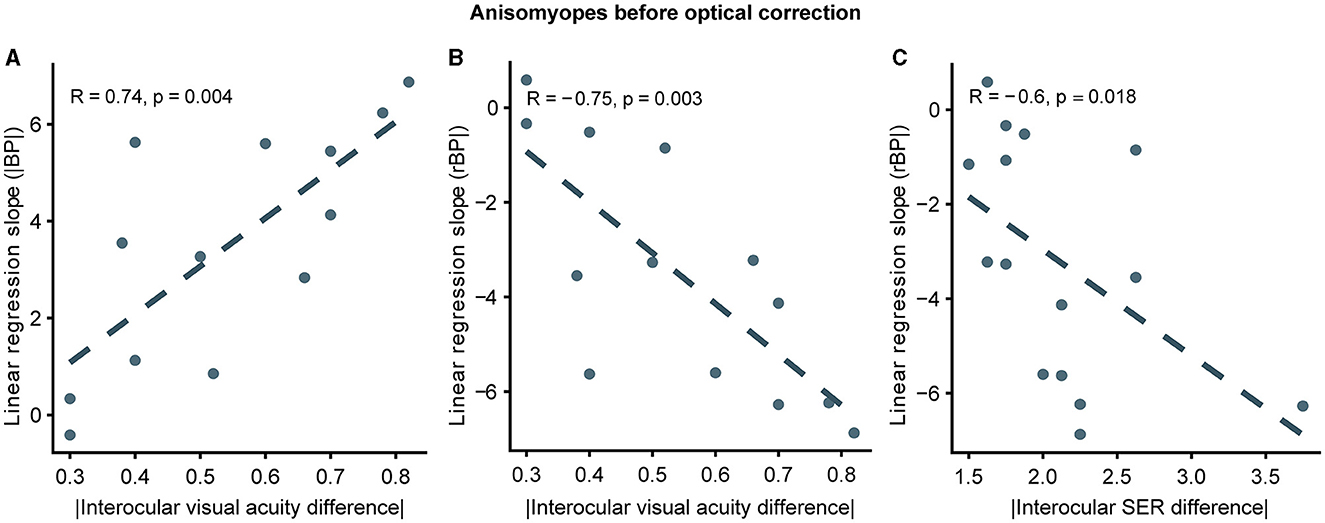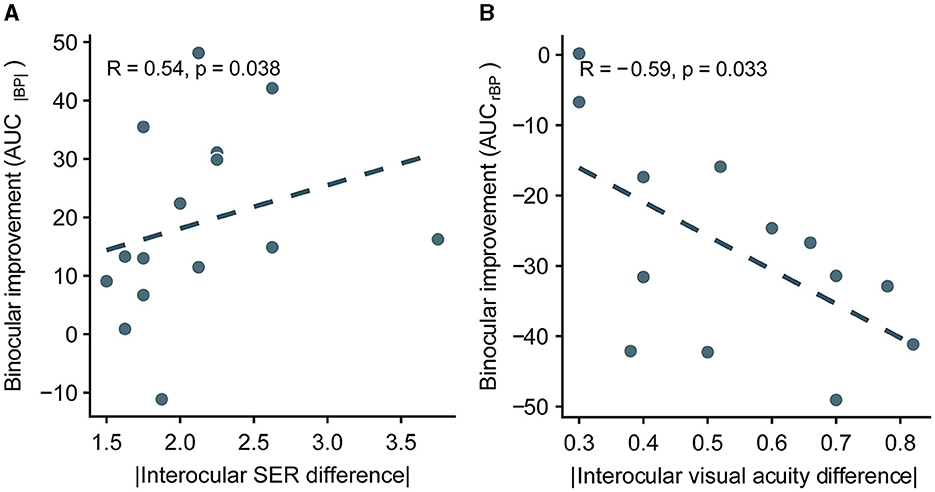
95% of researchers rate our articles as excellent or good
Learn more about the work of our research integrity team to safeguard the quality of each article we publish.
Find out more
CORRECTION article
Front. Neurosci. , 23 July 2024
Sec. Perception Science
Volume 18 - 2024 | https://doi.org/10.3389/fnins.2024.1457590
This article is a correction to:
Binocular balance across spatial frequency in anisomyopia
A corrigendum on
Binocular balance across spatial frequency in anisomyopia
by Jiang, N., Zheng, Y., Chen, M., Zhou, J., and Min, S. H. (2024). Front. Neurosci. 18:1349436. doi: 10.3389/fnins.2024.1349436
In the published article, there were errors in Figures 6C, 7A. Although the x-axis indicated the absolute value of interocular SER (spherical equivalent refraction) difference, some points were negative. The correct versions of Figures 6, 7 are shown below. Figure captions and the associated statistical results are the same as before.

Figure 6. Correlation between slopes and interocular differences in ocular features in uncorrected anisomyopes. (A) Correlation between slopes computed from |BP| and absolute values of interocular visual acuity difference. (B) Correlation between slopes computed from rBP and absolute values of interocular visual acuity difference. (C) Correlation between slopes computed from rBP and absolute values of interocular SER difference. SER, spherical equivalent refraction. Dark blue points represent anisomyopic individuals [n = 13 in panels (A, B); two subjects did not come for a follow-up session for visual acuity measurement]. The dotted lines are best-fit linear regressions from each scatter plot based on the correlation coefficient.

Figure 7. Correlation between the improvement of integrated binocular imbalance (the difference between AUC before optical correction and AUC after correction) from optical correction and the difference in ocular characteristics between two eyes in anisomyopia. (A) Correlation between the difference in AUCs computed from |BP| and absolute interocular SER difference. (B) Correlation between the difference in AUCs computed from rBP and absolute interocular visual acuity difference. SER, spherical equivalent refraction. The dashed lines are best-fit linear regressions from each scatter plot based on the correlation coefficient.
The authors apologize for this error and state that this does not change the scientific conclusions of the article in any way. The original article has been updated.
All claims expressed in this article are solely those of the authors and do not necessarily represent those of their affiliated organizations, or those of the publisher, the editors and the reviewers. Any product that may be evaluated in this article, or claim that may be made by its manufacturer, is not guaranteed or endorsed by the publisher.
Keywords: anisomyopia, binocular vision, contact lenses, axial length, visual acuity
Citation: Jiang N, Zheng Y, Chen M, Zhou J and Min SH (2024) Corrigendum: Binocular balance across spatial frequency in anisomyopia. Front. Neurosci. 18:1457590. doi: 10.3389/fnins.2024.1457590
Received: 01 July 2024; Accepted: 05 July 2024;
Published: 23 July 2024.
Edited and reviewed by: Zhongshu Tang, Sun Yat-sen University, China
Copyright © 2024 Jiang, Zheng, Chen, Zhou and Min. This is an open-access article distributed under the terms of the Creative Commons Attribution License (CC BY). The use, distribution or reproduction in other forums is permitted, provided the original author(s) and the copyright owner(s) are credited and that the original publication in this journal is cited, in accordance with accepted academic practice. No use, distribution or reproduction is permitted which does not comply with these terms.
*Correspondence: Jiawei Zhou, emhvdWp3QG1haWwuZXllLmFjLmNu; Seung Hyun Min, c2V1bmcubWluQGV5ZS5hYy5jbg==
Disclaimer: All claims expressed in this article are solely those of the authors and do not necessarily represent those of their affiliated organizations, or those of the publisher, the editors and the reviewers. Any product that may be evaluated in this article or claim that may be made by its manufacturer is not guaranteed or endorsed by the publisher.
Research integrity at Frontiers

Learn more about the work of our research integrity team to safeguard the quality of each article we publish.